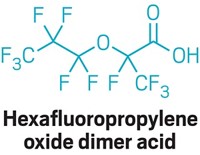Advertisement
Grab your lab coat. Let's get started
Welcome!
Welcome!
Create an account below to get 6 C&EN articles per month, receive newsletters and more - all free.
It seems this is your first time logging in online. Please enter the following information to continue.
As an ACS member you automatically get access to this site. All we need is few more details to create your reading experience.
Not you? Sign in with a different account.
Not you? Sign in with a different account.
ERROR 1
ERROR 1
ERROR 2
ERROR 2
ERROR 2
ERROR 2
ERROR 2
Password and Confirm password must match.
If you have an ACS member number, please enter it here so we can link this account to your membership. (optional)
ERROR 2
ACS values your privacy. By submitting your information, you are gaining access to C&EN and subscribing to our weekly newsletter. We use the information you provide to make your reading experience better, and we will never sell your data to third party members.
Environment
Cleaning Up Dow's Dioxins
by Rudy Baum
August 11, 2008
| A version of this story appeared in
Volume 86, Issue 32
This week's cover is designed to make you look twice. In C&EN's current design, the cover is supposed to be an image with a strong central focus. An empty swing set in an empty park? Where's the focus?
Then your gaze shifts to the sign on the periphery of the image. The dire warning—CONTAMINATION ADVISORY, Avoid Contact with Soil & River Sediment Due to Dioxin Contamination, Please use soap and water to wash off soil or sediment—explains the empty park.
The cover photograph was taken in Saginaw, Mich., by Senior Editor Cheryl Hogue, who traveled to the state to gather information and interview sources for the cover story she wrote on dioxin contamination of two rivers downstream from Dow Chemical's Midland manufacturing complex (see page 15). Hogue also took all of the photographs that accompany the story.
It is a complex, compelling article. As Hogue writes, Dow and federal and state regulators agree that the dioxin contamination of the Tittabawasee and Saginaw Rivers is a result of past Dow operations. They also agree that cleanup work needs to be done and that Dow must pay for it. "From there," Hogue writes, "they diverge."
She interviewed many of the key players in this saga. There is Michelle Hurd Riddick of the Lone Tree Council, an environmental group that has been calling for Dow to remove the dioxin contamination for decades. "You made a mess. Clean it up," Hurd Riddick says of Dow's responsibility.
There is John C. Musser, a spokesman for Dow's Michigan operations, who says the company believes that much of the contamination downstream of its plant poses no imminent threat to humans or the environment because there is little chance for exposure. Cleanup, Musser says, should be targeted to areas where there is a "realistic probability of exposure."
There are representatives of the Environmental Protection Agency, which Dow would like to see in charge of any cleanup, and Michigan's Department of Environmental Quality (DEQ), which currently has that authority. While the state and federal agencies cooperate and agree that residential properties with soils contaminated with dioxins should get top priority for cleanup, in the past "the two agencies have struggled with how best to go about the rest of the cleanup," Hogue writes. DEQ spokesman Robert McCann told Hogue that the two agencies are now "on the same page" in their focus on protecting human health.
Yes, but not entirely. For example, EPA relies on an "action level" of 1,000 ppt of dioxins in residential areas on or near polluted sites as a threshold for triggering responses by regulators to prevent exposure. By contrast, in 1995 DEQ adopted an action level of 90 ppt for residential property. That's a pretty significant difference.
Of the DEQ action level, Musser says, "We view that as being extreme and very overprotective."
In reading Hogue's story, however, I was struck less by the disagreements among various stakeholders than by the measured tone of the discourse among them. I am old enough to remember a time when environmental activists, environmental regulators, and chemical companies more often than not shouted past one another rather than engaged each other.
Despite disagreements over the cleanup with DEQ and EPA, Hogue writes, "Dow is finding middle ground with the regulatory agencies, according to Musser. 'We're in a pretty good place,' he says. 'There's an air of reasonableness and genuine interest in finding ways to move the process forward that we haven't seen in the last year or so.' "
I think that is remarkable progress and a very healthy sign for the future of the chemical industry.
Thanks for reading.
Views expressed on this page are those of the author and not necessarily those of ACS.
Cover Story
- Dow's Dioxins
- Saga of pollution, politics, and struggle over cleanup has nationwide implications
- What's In The Rivers?
- The Tittabawasee and Saginaw Rivers are tainted with a variety of persistent, chlorinated toxic substances
- Editor's Page: Cleaning Up Dow's Dioxins





Join the conversation
Contact the reporter
Submit a Letter to the Editor for publication
Engage with us on Twitter